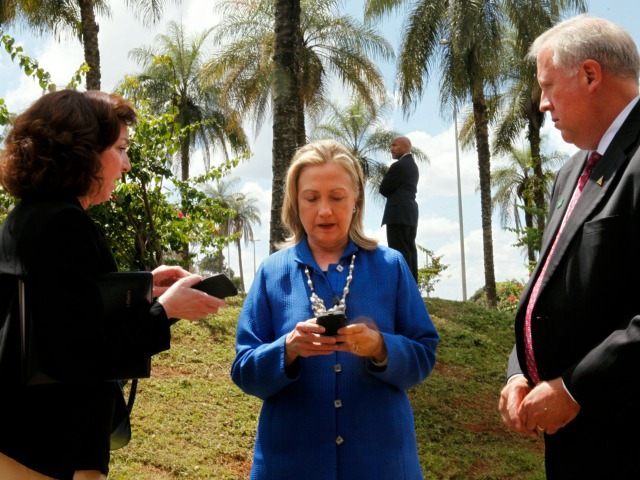Secretary of State Hillary Clinton rejected a hacker-protected cellphone developed by General Dynamics once the National Security Agency declined to give her the same “special secure” BlackBerry that President Barack Obama carried.
The latest batch of State Department documents recently obtained by Judicial Watch in a Freedom of Information Act (FOIA) lawsuit regarding Hillary Clinton’s use of a private email server while serving as Secretary of State revealed that she repeatedly sought to obtain an uncrackable “Blackberry-like communications” device to be used by her and her staff in their Sensitive Compartmented Information Facility offices. But the Secretary of State was rebuffed by the National Security Agency due to security and cost concerns.
The FOIA-obtained documents detail that Donald R. Reid as the State Department’s Senior Coordinator for Security Infrastructure at the Bureau of Diplomatic Security knew the Blackberry (BB) that President Obama carried wasn’t designed to be secure enough to send classified email — only to protect its microphone from being remotely hijacked by cyber-spies, according to Wired magazine.
But Reid persisted in a February 18, 2009 email to the NSA, because Secretary Clinton:
does not use a personal computer so our view of someone wedded to their email (why doesn’t she use her desktop when in SCIF?) doesn’t fit this scenario … during the campaign she was urged to keep in contact with thousands via a BB … once she got the hang of it she was hooked … now everyday [sic], she feels hamstrung because she has to lock her BB up … she does go out several times a day to an office they have crafted for her outside the SCIF and plays email catch up … Cheryl Mills and others who are dedicated BB addicts are frustrated because they too are not near their desktop very often during the working day.
The Secretary of State and her staff had developed a “personal comfort” using Blackberry technology during Clinton’s failed 2008 presidential campaign, and were angry because Blackberry security waivers were issued to Secretary of State Condoleezza Rice and her staff. But the NSA stated that “use expanded to an unmanageable number of users from a security perspective, so those waivers were phased out and Blackberry use was not allowed in her suite.”
For more special secure mobile hardware, the NSA suggested Secretary Clinton use a “Sectéra Edge” phone developed by General Dynamics under the direction of the NSA as part of the Secure Mobile Environment Portable Electronic Device (SME PED) program. The Sectéra Edge cost $4,750 per unit and ran a special hardened version of Windows CE software that supported the necessary protocols to access classified information on top secret government networks and place encrypted calls to other similarly trusted devices, according to by Ziff Davis Media’s Extreme Tech.
But the Sectéra Edge also needed to be connected to a Apriva email server specifically configured for mobile devices. It was “estimated that setting up a single user on the Sectéra Edge would cost the government about $30,000,” according to ARS Technica.
The Defense Mobile Classified Capability-Secret (DMCC-S) launched in 2015 replaced the SME PED. Rather than designing DMCC-S smartphones from the ground up, the Defense Department now uses commercially available smartphones with Bluetooth disabled. Secretary of State John Kerry received one of the first DMCC-S phones, a Samsung Galaxy S4.

COMMENTS
Please let us know if you're having issues with commenting.